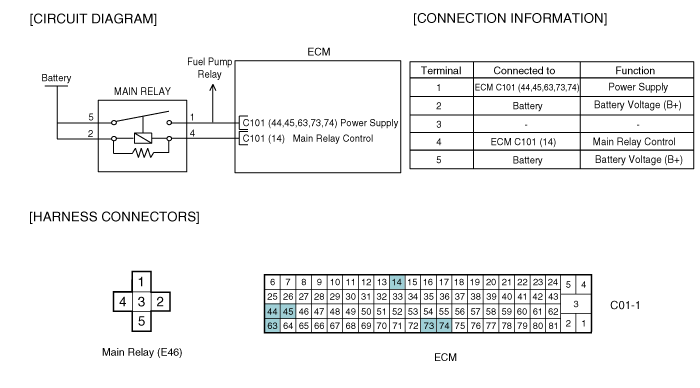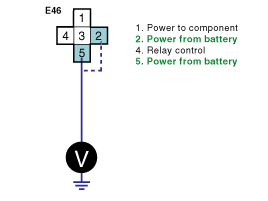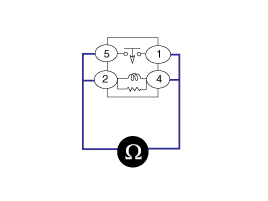Monitor the "Main relay" parameters on the scantool.


The purpose of the System Voltage is to detect an excessively low or high system voltage that may be caused by a malfunctioning charging system.
System Voltage is the ignition voltage potential at the Powertrain Control Module (PCM)PCM measures and compares voltage from ignition key and each relay. With this mechanism, PCM knows if the main relay switch turns on after IG on or if turns OFF after IG off.
If the system voltage is over 17 V during 0.2 sec, PCM sets DTC P0563.
Item | Detecting Condition | Possible Cause |
DTC Strategy | ● Signal check, high | ● Poor connection ● Charging system ● Main relay ● ECM |
Enable Conditions | ● Time after engine start 〉 120 sec ● Vehicle speed 〉 25 kph | |
Threshold Value | ● Voltage 〉 17 V | |
Diagnostic Time | ● 0.2 sec | |
MIL ON Condition | ● 3 driving cycle |

Connect scantool to Data Link Connector(DLC).
Warm up the engine to normal operating temperature.
Monitor the "Main relay" parameters on the scantool.

Are the parameters displayed correctly?

▶ Fault is intermittent caused by poor contact in the sensor’s and/or ECM’s connector or wasrepaired and ECM memory was not cleared. Thoroughly check connectors for looseness, poorconnection, bending, corrosion, contamination, deterioration, or damage. Repair or replace as necessary and go to "Verification of vehicle Repair" procedure.

▶ Go to "Terminal and connector inspection" procedure.
Many malfunctions in the electrical system are caused by poor harness and terminals. Faults can also be caused by interference from other electrical systems, and mechanical or chemical damage.
Thoroughly check connectors for looseness, poor connection, bending, corrosion, contamination, deterioration, or damage.
Has a problem been found?

▶ Repair as necessary and go to "Verification of vehicle Repair" procedure.

▶ Go to "Main relay circuit inspection" procedure.
Key "OFF".
Disconnect Main relay and Key "ON".
Measure the voltage between terminal 2 of main relay harness connector and chassis ground.
Measure the voltage between terminal 5 of main relay harness connector and chassis ground.
Specification : B+

Is the measured voltage within specification?

▶ Go to "System inspection" procedure.

▶ Check the fuse(ECU A 30A) between battery and main relay.
▶ Repair short in power circuit and then go to "Verification of vehicle Repair" procedure.
Alternator circuit check.
Key "OFF".
Disconnect alternator connector.
Key "ON" & ENG "OFF".
Measure the voltage between terminal 1 of alternator harness connector and chassis ground.
Measure the voltage between terminal 2 of alternator harness connector and chassis ground.
Specification : B+

Is the measured voltage within specification?

▶ Go to "Component inspection" procedure.

▶ In case there is no voltage detected at terminal 1, check Open circuit, Battery and Fuse(MAIN 120 A)between battery and alternator. And then go to "Verification of vehicle Repair" procedure.
▶ In case there is no voltage detected at terminal 2, check Open circuit, MIL circuit and MIL resistor. And then go to "Verification of vehicle Repair" procedure.
Main relay check.
Key "OFF".
Disconnect Main relay.
Measure the resistance between terminal 1 and 5 of main relay. (Component side)
Measure the resistance between terminal 2 and 4 of main relay. (Component side)
Terminal | Power Approval |
1~5 | NO |
2~4 | YES (Approx. 70Ω ~ 120Ω) |

Is the measured resistance within specifications?

▶ Go to "Alternator check" procedure.

▶ Substitute with a known - good Main relay and check for proper operation.
▶ If the problem is corrected, replace Main relay and go to "Verification of Vehicle Repair" procedure.
Alternator check.
Key "OFF".
Check the tension of alternator belt.
Check corrosion, damage or looseness of Battery terminal and Alternator terminal.
Engine start.
Operate electrical parts(Head lamp, Defoger, etc).
Measure the voltage at 2000rpm.
Specification : Approx 12.5V ~ 14.5V
Is the measured voltage within specifications?

▶ Substitute with a known - good ECM and check for proper operation.
▶ If the problem is corrected, replace ECM and go to "Verification of Vehicle Repair" procedure.

▶ Substitute with a known - good Alternator and check for proper operation.
▶ If the problem is corrected, replace Alternator and go to "Verification of Vehicle Repair" procedure.
After a repair, it is essential to verify that the fault has been corrected.
Connect scan tool and select "Diagnostic Trouble Codes(DTCs)" mode.
Clear the DTCs and Operate the vehicle within DTC Enable conditions in General information.
Are any DTCs present ?

▶ Go to the applicable troubleshooting procedure.

▶ System is performing to specification at this time.